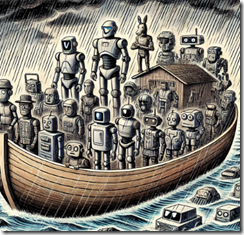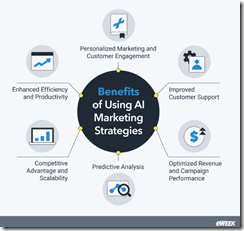AI Doom: Really Smart Software Is Coming So Start Being Afraid, People
January 20, 2025
 Prepared by a still-alive dinobaby.
Prepared by a still-alive dinobaby.
The essay “Prophecies of the Flood” gathers several comments about software that thinks and decides without any humans fiddling around. The “flood” metaphor evokes the streams of money about which money people fantasize. The word “flood” evokes the Hebrew Biblical idea’s presentation of a divinely initiated cataclysm intended to cleanse the Earth of widespread wickedness. Plus, one cannot overlook the image of small towns in North Carolina inundated in mud and debris from a very bad storm.
When the AI flood strikes as a form of divine retribution, will the modern arc be filled with humans? Nope. The survivors will be those smart agents infused with even smarter software. Tough luck, humanoids. Thanks, OpenAI, I knew you could deliver art that is good enough.
To sum up: A flood is bad news, people.
The essay states:
the researchers and engineers inside AI labs appear genuinely convinced they’re witnessing the emergence of something unprecedented. Their certainty alone wouldn’t matter – except that increasingly public benchmarks and demonstrations are beginning to hint at why they might believe we’re approaching a fundamental shift in AI capabilities. The water, as it were, seems to be rising faster than expected.
The signs of darkness, according to the essay, include:
- Rising water in the generally predictable technology stream in the park populated with ducks
- Agents that “do” something for the human user or another smart software system. To humans with MBAs, art history degrees, and programming skills honed at a boot camp, the smart software is magical. Merlin wears a gray T shirt, sneakers, and faded denims
- Nifty art output in the form of images and — gasp! — videos.
The essay concludes:
The flood of intelligence that may be coming isn’t inherently good or bad – but how we prepare for it, how we adapt to it, and most importantly, how we choose to use it, will determine whether it becomes a force for progress or disruption. The time to start having these conversations isn’t after the water starts rising – it’s now.
Let’s assume that I buy this analysis and agree with the notion “prepare now.” How realistic is it that the United Nations, a couple of super powers, or a motivated individual can have an impact? Gentle reader, doom sells. Examples include The Big Short: Inside the Doomsday Machine, The Shifts and Shocks: What We’ve Learned – and Have Still to Learn – from the Financial Crisis, and Too Big to Fail: How Wall Street and Washington Fought to Save the Financial System from Crisis – and Themselves, and others, many others.
Have these dissections of problems had a material effect on regulators, elected officials, or the people in the bank down the street from your residence? Answer: Nope.
Several observations:
- Technology doom works because innovations have positive and negative impacts. To make technology exciting, no one is exactly sure what the knock on effects will be. Therefore, doom is coming along with the good parts
- Taking a contrary point of view creates opportunities to engage with those who want to hear something different. Insecurity is a powerful sales tool.
- Sending messages about future impacts pulls clicks. Clicks are important.
Net net: The AI revolution is a trope. Never mind that after decades of researchers’ work, a revolution has arrived. Lionel Messi allegedly said, “It took me 17 years to become an overnight success.” (Mr. Messi is a highly regarded professional soccer player.)
Will the ill-defined technology kill humans? Answer: Who knows. Will humans using ill-defined technology like smart software kill humans? Answer: Absolutely. Can “anyone” or “anything” take an action to prevent AI technology from rippling through society. Answer: Nope.
Stephen E Arnold, January 20, 2025
National Security: A Last Minute Job?
January 20, 2025
On its way out the door, the Biden administration has enacted a prudent policy. Whether it will persist long under the new administration is anyone’s guess. The White House Briefing Room released a “Fact Sheet: Ensuring U.S. Security and Economic Strength in the Age of Artificial Intelligence.” The rule provides six key mechanisms on the diffusion of U.S. Technology. The statement specifies:
“In the wrong hands, powerful AI systems have the potential to exacerbate significant national security risks, including by enabling the development of weapons of mass destruction, supporting powerful offensive cyber operations, and aiding human rights abuses, such as mass surveillance. Today, countries of concern actively employ AI – including U.S.-made AI – in this way, and seek to undermine U.S. AI leadership. To enhance U.S. national security and economic strength, it is essential that we do not offshore this critical technology and that the world’s AI runs on American rails. It is important to work with AI companies and foreign governments to put in place critical security and trust standards as they build out their AI ecosystems. To strengthen U.S. security and economic strength, the Biden-Harris Administration today is releasing an Interim Final Rule on Artificial Intelligence Diffusion. It streamlines licensing hurdles for both large and small chip orders, bolsters U.S. AI leadership, and provides clarity to allied and partner nations about how they can benefit from AI. It builds on previous chip controls by thwarting smuggling, closing other loopholes, and raising AI security standards.”
The six mechanisms specify 18 key allies to whom no restrictions apply and create a couple trusted statuses other entities can attain. They also support cooperation between governments on export controls, clean energy, and technology security. As for “countries of concern,” the rule seeks to ensure certain advanced technologies do not make it into their hands. See the briefing for more details.
The measures add to previous security provisions, including the October 2022 and October 2023 chip controls. We are assured they were informed by conversations with stakeholders, bipartisan members of Congress, industry representatives, and foreign allies over the previous 10 months. Sounds like it was a lot of work. Let us hope it does not soon become wasted effort.
Cynthia Murrell, January 20, 2025
Bossless: Managers of the Future Recognize They Cannot Fix Management or Themselves
January 17, 2025
 A dinobaby-crafted post. I confess. I used smart software to create the heart wrenching scene of a farmer facing a tough 2025.
A dinobaby-crafted post. I confess. I used smart software to create the heart wrenching scene of a farmer facing a tough 2025.
I have never heard of Robert Walters. Sure, I worked on projects in London for several years, but that outfit never hit my radar. Now it has, and I think its write up is quite interesting. “Conscious Unbossing – 52% of Gen-Z Professionals Don’t Want to Be Middle Managers” introduced me to a new bound phrase: Conscious unbossing. That is super and much more elegant than the coinage ensh*tification.
A conscious unbosser looks in the mirror and sees pain. He thinks, “I can’t make the decision to keep or fire Tameka. I can’t do the budget because I don’t have my MBA study group to help me. I can’t give that talk to the sales team because I have never sold a thing in my life. Thanks, MSFT Copilot. I figured out how to make you work again. Too bad about killing those scanners, right?
The write up reports:
Over half of Gen-Z professionals don’t want to take on a middle management role in their career.
Is there some analysis? Well, sort of. The Robert Walters outfit offers this:
The Robert Walters poll found that 72% of Gen-Z would actually opt for an individual route to advance their career – one which focuses on personal growth and skills accumulation over taking on a management role (28%). Lucy Bisset, Director of Robert Walters North comments: “Gen-Z are known for their entrepreneurial mindset – preferring to bring their ‘whole self’ to projects and spend time cultivating their own brand and approach, rather than spending time managing others. “However, this reluctance to take on middle management roles could spell trouble for employers later down the line.”
The entrepreneurial mindset and “whole self” desire are what the survey sample’s results suggest. The bigger issue, in my opinion, is, “What’s caused a big chunk of Gen-Z (whatever that is) to want to have a “brand” and avoid the responsibility of making decisions, dealing with consequences (good and bad) of those decisions, and working with people to build a process that outputs results?”
Robert Walters sidesteps this question. Let me take a whack at why the Gen-Z crowd (people who were 23 to 38 in 2019) are into what I call “soft” work and getting paid to have experiences work.
- This group grew up with awards for nothing. Run in a race, lose, and get a badge. Do this enough and the “losers” come to know that they are non-performers no matter what mommy, daddy, and the gym teacher told them.
- Gen-Z was a group who matured in a fantasy land with nifty computers, mobile phones, and social media. Certain life skills were not refined in the heat treating process of a competitive education.
- Affirmation and attention became more important as their social opportunities narrowed. The great tattooing craze grabbed hold of those in Gen-Z. When I see a 32 year old restaurant worker adorned with tattoos, I wonder, “What the heck was he/she/ze thinking? I know what I am thinking, “Insecurity. A desire to stand out. A permanent “also participated” badge which will look snappy when the tattooed person is 70 years old.
Net net: I think the data in the write up is suggestive. I have questions about the sample size, the method of selection, and the statistical approach taken to determine if a “result” is verifiable. One thing is certain. Outfits like McKinsey, Bain, and BCG will have to rework their standard slide decks for personnel planning and management techniques. However, I can overlook the sparse information in the write up and the shallow analysis. I love that “conscious unbossing” neologism. See, there is room for sociology and psychology majors in business. Not much. But some room.
Stephen E Arnold, January 17, 2025
IBM Tells Google, Mine Is Bigger! But Can the Kookaburra Eat the Reptile Googzilla?
January 17, 2025
 Prepared by a still-alive dinobaby.
Prepared by a still-alive dinobaby.
The “who has the biggest nose” contest is in gear for 2025. I read “IBM Will Release the Largest Ever Quantum Computer in 2025.” Forget the Nvidia wizard’s pushing usable quantum computing into the far future. Forget the Intel Horse Features — sorry, horse collar — statements. Forget the challenge of making a programming language which makes it possible to create an application for a Oura smart ring. Bigger is where it is at in the quantum marketing world.
The write up reports with the repeatability of most research projects:
… The company’s largest quantum chip, called Condor, has 1121 qubits, though IBM’s Jay Gambetta says the average user of its quantum computing services only works with 100 qubits… The only way to get quantum advantage is to combine different components.” This is an issue of engineering as much as it is of quantum physics – as the number of qubits increases it becomes more practically difficult to fit all of them and the quantum computer’s input and output wires onto a single chip.
So what is IBM doing? Bolting stuff together, thank you very much.
But IBM is thinking beyond the Condor. The next innovation from IBM is Kookaburra. (This is a bird whose call is the sound of human laughter. I must come clean. When I read about this quantum achievement from IBM I did laugh. When I learned that chip’s name, I chuckled again. To be fair, I laughed more whenever I encountered the cognitive whiz kid Watson. But Kookaburra is hoot, especially for those who grew up in Australia or New Guinea.)
The write up says:
The task now is to increase that total number while making sure the qubits don’t make more errors than when the chips are kept separate.
Yep, bolting stuff together works great.
I am eagerly awaiting Google’s response because it perceives itself an quantumly supreme. I think when I laugh at the content marketing these big technology outfits output, I sound like a Kookaburra. (Did you know that a Kookaburra can weigh up to a half a pound plus they are carnivorous. This was an attribute when IBM was a much more significant player in the computer market. Kookaburras eat mice and snakes. Yeah, the Kookaburra.
Stephen E Arnold, January 17, 2025
Microsoft: Marketing and Semi Functional Technology Amuse Some People
January 17, 2025
 Prepared by a still-alive dinobaby.
Prepared by a still-alive dinobaby.
With support for Windows 10 ending, Microsoft is understandably eager for users to upgrade before then. Its latest nudge, however, may not have the desired effect. TechRadar reports, "Microsoft Embarrasses Itself with Windows 10 Pop-Up that Hogs the Desktop Urging an Upgrade to Windows 11—then Promptly Crashes." Oh dear. Writer Darren Allen elaborates:
"In a rather embarrassing turn of events for Microsoft, its latest bid to urge Windows 10 users to upgrade to Windows 11 has gone awry because the pop-up in question crashes. This is a full-screen pop-up, of which we’ve seen very similar (if not identical) variants before, which urges you to ‘Start planning for Windows 10 end of support’ ahead of the End of Life date for the OS which is October 2025. … The fresh wrinkle here, though, as Windows Latest reports, is that this pop-up is crashing for some Windows 10 users, as flagged up by a denizen of X (@ems_konto). So, what we have here is a message urging you to start planning what you’ll do when Windows 10 support runs out, telling you to prepare now, and that the Windows Backup app can help you transfer all your files to a new Windows 11 PC. And then the pop-up window immediately freezes, becomes unresponsive, and informs the user that ‘Reusable UX Interaction Manager is not working’ – whoops."
Not great for a company trying to usher users into the next iteration of its OS. Will users lose confidence and look elsewhere? A few Windows alternatives do exist, though none that are both cheap and easy to migrate to. Will more folks consider the adventure of using Linux? Perhaps a few will ditch the PC altogether for a Mac. We suspect most will just stick with the company they know, embarrassing glitches and all. Inertia, marketing, and good enough engineering are hallmarks of the company absolutely everyone eager to have a digital mom reminding them to do what is right and proper. Does mom follow the rules? Nah, my mother was a PTA cookie hustler. Who knows that one’s mom really did?
Stephen E Arnold, January 17, 2025
Amazon Embodies Modern Management: Efficient, Effective, Encouraging
January 16, 2025
 A dinobaby-crafted post. I confess. I used smart software to create the heart wrenching scene of a farmer facing a tough 2025.
A dinobaby-crafted post. I confess. I used smart software to create the heart wrenching scene of a farmer facing a tough 2025.
I don’t know if this write up is spot on, but I loved it. Navigate to “Amazon Worker – Struck and Shot in New Orleans Terror Attack – Initially Denied Time Off.” If the link is dead, complain to MSFT, please. (Perhaps the headline tells the tale?) The article pointed out:
Alexis Scott-Windham was celebrating the New Year with friends on Bourbon Street when a pickup truck mounted the sidewalk and rammed a crowd shortly after 3 am local time. She was treated in hospital after the back of her right foot was run over by the vehicle, and she was also shot in the foot. The bullet remains in her limb while doctors work out the best course of action to remove it while she recovers at home. The regional Times-Picayune newspaper interviewed Scott-Windham, who revealed she had been denied medical leave by the Amazon warehouse where she works for a medical checkup in two weeks’ time. The mother feared if she was absent from work for that appointment, she would lose her job.
Several observations are warranted:
-
Struck means that the vehicle hit her. That would probably test the situational awareness of a Delta Force operator walking with pals to the Green Beans.
-
Shot. Now when a person is shot, there is the wound itself. However, the shock and subsequent pain are to some annoying. I knew a person who flinched each time a sharp sound interrupted a conversation. That individual, who received a military award for bravery, told me, “Just a reflex.” Sure. Reflex. Hard wired decades after the incident in the Vietnam “conflict.”
-
Fear of being fired for injuries incurred in a terrorist incident. That’s a nifty way to motivate employees to do their best and trust an organization.
Herewith, the dinobaby award for outstanding management goes to the real or virtual individual who informed the person injured in the terrorist attack the Outstanding Management insignia. Wear it proudly. When terminating people, the insignia is known to blink in Morse code, “Amazon is wonderful.”
Stephen E Arnold, January 16, 2025
How To: Create Junk Online Content with AI
January 16, 2025
 A dinobaby produced this post. Sorry. No smart software was able to help the 80 year old this time around.
A dinobaby produced this post. Sorry. No smart software was able to help the 80 year old this time around.
Why sign up for a Telegram SEO expert in Myanmar or the Philippines? You can do it yourself. An explainer called “AI Marketing Strategy: How to Use AI for Marketing (Examples & Tools)” provides the recipe. The upside? Well, I am not sure. The downside? More baloney with which to dupe smart software and dumb humans.
What does the free write up cover? Here’s the list of topics. Which whet your appetite for AI-generated baloney?
- A definition of AI marketing
- How to use AI in your strategy for cutting corners and whacking out “real” information
- The steps you have to follow to find the pot of gold
- The benefits of being really smart with smart software
- The three — count them — types of smart software marketing
- The three — count them — “best” AI marketing software (I love “best”. So credible)
- A smart software FAQ
- How to “future proof” your business with an AI marketing strategy.
Let me give you an example of the riches tucked inside this EWeek “real” news article. The write up says:
Maintain data quality
Okay, marketers are among the world’s leaders in data accuracy, thoroughness, and detail fact checking. That’s why the handful of giant outfits providing smart software explain how to keep cheese on pizza with glue and hallucinate.
Why should one use smart software to market? That’s easy. The answer is that smart software makes it easy to produce output which may be incorrect. If you want more benefits, here’s the graphic from the write up which explains it to short-cutters who don’t want to spend time doing work the old-fashioned way:
A graphic which may or may not have been produced with smart software designed to create “McKinsey” type illustrations suitable for executives with imposter syndrome.
This graphic is followed by an explanation of the three — count them — three types of AI marketing. I am not sure the items listed are marketing, but, hey, when one is doing a deep dive one doesn’t linger too long deep in the content ocean with concepts like machine learning, natural language processing, and computer vision. (I am not joking. These are the three types of AI marketing. Who knew? Certainly not this dinobaby.
The author, according to the definitive write up, possesses “more than 10 years of experience covering technology, software, and news.” The home base for this professional is the Philippines, which along with Thailand and Cambodia, one of the hot beds for a wide range of activities, including the use of smart software to generate those SEO services publicized on Telegram.
Was the eWeek article written with the help of AI? Boy, this dinobaby doesn’t know.
Stephen E Arnold, January 16, 2025
Can the UN Control the Intelligence Units of Countries? Yeah, Sure. No Problem
January 16, 2025
 This blog post is the work of an authentic dinobaby. Sorry. No smart software can help this reptilian thinker.
This blog post is the work of an authentic dinobaby. Sorry. No smart software can help this reptilian thinker.
I assume that the information in “Governments Call for Spyware Regulations in UN Security Council Meeting” is spot on or very close to the bull’s eye. The write up reports:
On Tuesday [January 14, 2025] , the United Nations Security Council held a meeting to discuss the dangers of commercial spyware, which marks the first time this type of software — also known as government or mercenary spyware — has been discussed at the Security Council. The goal of the meeting, according to the U.S. Mission to the UN, was to “address the implications of the proliferation and misuse of commercial spyware for the maintenance of international peace and security.” The United States and 15 other countries called for the meeting.
Not surprisingly, different countries had different points of view. These ranged from “we have local regulations” to giant nation state assertions about bad actions by governments being more important to it is the USA’s fault.
The write up from the ubiquitous intelligence commentator did not include any history, context, or practical commentary about the diffusion of awareness of intelware or what the article, the UN, and my 90 year old neighbor calls spyware.
The public awareness of intelware coincided with hacks of some highly regarded technology. I am not going to name this product, but if one pokes about one might find documentation, code snippets, and even some conference material. Ah, ha. The conference material was obviously designed for marketing. Yes, that is correct. Conferences are routinely held in which the participants are vetted and certain measures put in place to prevent leakage of these materials. However, once someone passes out a brochure, the information is on the loose and can be snagged by a curious reporter who wants to do good. Also, some conference organizers themselves make disastrous decisions about what to post on their conference web site; for example, the presentations. I give some presentations at these closed to the public events, and I have found my slide deck on the organizer’s Web site. I won’t mention this outfit, but I don’t participate in any events associated with this outfit. Also, some conference attendees dress up as sheep and register with possibly bogus information. These folks happily snap pictures of exhibits of hardware not available to the public, record audio, and at one event held in the Hague sat in front of me and did a recording of my lecture about some odd ball research project in which I was involved. I reported the incident to the people at the conference desk. I learned that the individual left the conference and that his office telephone number was bogus. That’s enough. Leaks do occur. People are careless. Others just clever and duplicitous.
Thanks, You.com. You are barely able to manage a “good enough” these days. Money problems? Yeah, too bad. My heart bleeds for you.
However, the big reveal of intelware and its cousin policeware coincided with the push by one nation state. I won’t mention the country, but here’s how I perceived what kicked into high gear in 2005 or so. A number of start ups offered data analytics. The basic pitch was that these outfits had developed a suite of procedures to make sense of data. If the client had data, these companies could import the information and display important points identified by algorithms about the numbers, entities, and times. Marketers were interested in these systems because, like the sale pitches for AI today, the Madison Avenue crowd could dispense with the humans doing the tedious hand work required to make sense of pharmaceutical information. Buy, recycle, or create a data set. Then import it into these systems. Business intelligence spills forth. Leaders in this field did not disclose their “roots” in the intelligence community of the nation encouraging its entrepreneurs to commercialize what they learned when fulfilling their government military service.
Where did the funding come from? The nation state referenced provided some seed funds. However, in order to keep these systems in line with customer requirements for analyzing the sales of shampoo and blockbuster movies. Venture firms with personnel familiar with the nation state’s government software innovations were invited to participate in funding some of these outfits. One of them is a very large publicly traded company. This firm has a commercial sales side and a government sales side. Some readers of this post will have the stock in their mutual fund stock baskets. Once a couple of these outfits hit the financial jackpot for the venture firms, the race was on.
Companies once focused squarely on serving classified entities in a government in a number of countries wanted to sanitize the software and sell to a much larger, more diverse corporate market. Today, if one wants to kick the tires of commercially available once-classified systems and methods, one can:
- Attend conferences about data brokering
- Travel to Barcelona or Singapore and contact interesting start ups and small businesses in the marketing data analysis business
- Sign up for free open source intelligence online events and note the names and organizations speaking. (Some of these events allow a registered attendee to conduct an off line for others but real time chat with a speaker who represents an interesting company.
There are more techniques as well to identify outfits which are in the business of providing or developing intelware and policeware tools for anyone with money. How do you find these folks? That’s easy. Dark Web searches, Telegram Group surfing, and running an advertisement for a job requiring a person with specialized experience in a region like southeast Asia.
Now let me return to the topic of the cited article: The UN’s efforts to get governments to create rules, controls, or policies for intelware and policeware. Several observations:
- The effort is effectively decades too late
- The trajectory of high powered technology is outward from its original intended purpose
- Greed because the software works and can generate useful results: Money or genuinely valuable information.
Agree or disagree with me? That’s okay. I did a few small jobs for a couple of these outfits and have just enough insight to point out that the article “Governments Call for Spyware Regulations in UN Security Council Meeting” presents a somewhat thin report and lacks color.
Stephen E Arnold, January 18, 2025
Racers, Start Your Work Around Engines
January 16, 2025
 Prepared by a still-alive dinobaby.
Prepared by a still-alive dinobaby.
Companies are now prohibited from sending our personal information to specific, hostile nations. Because tech firms must be forced to exercise common sense, apparently. TechRadar reports, "US Government Says Companies Are No Longer Allowed to Send Bulk Data to these Nations." The restriction is the final step in implementing Executive Order 14117, which President Biden signed nearly a year ago. It is to take effect at the beginning of April.
The rule names six countries the DoJ says have “engaged in a long-term pattern or serious instances of conduct significantly adverse to the national security of the United States or the security and safety of U.S. persons”: China, Cuba, Iran, North Korea, Russia, and Venezuela. Writer Benedict Collins tells us:
"The Executive Order is aimed at preventing countries generally hostile to the US from using the data of US citizens in cyber espionage and influence campaigns, as well as building profiles of US citizens to be used in social engineering, phishing, blackmail, and identity theft campaigns. The final rule sets out the threshold for transactions of data that carry an unacceptable level of risk, alongside the different classes of transactions that are prohibited, restricted or exempt. Companies that violate the order will face civil and criminal penalties."
The restriction covers geolocation data; personal identifiers like social security numbers; biometric identifiers; personal health data; personal financial information; and data on our very cells. The agency clarifies some activities that are not prohibited:
"The DoJ also outlined the final rule does not apply to ‘medical, health, or science research or the development and marketing of new drugs’ and ‘also does not broadly prohibit U.S. persons from engaging in commercial transactions, including exchanging financial and other data as part of the sale of commercial goods and services with countries of concern or covered persons, or impose measures aimed at a broader decoupling of the substantial consumer, economic, scientific, and trade relationships that the United States has with other countries.’"
So, outside those exceptions, the idea is that US firms will not be sending our personal data to these hostile countries. That is the theory. However, organizations gather data from mobile phone apps, from exfiltrated mobile phone records, from “gray” data aggregators. How does one find entities providing conduits for information outflows? A bit of sleuthing on Telegram or searches on Dark Web search engines provide a number of contact points. Are the data reliable, accurate, and timely? Bad data are plentiful, but by acquiring or assembling information, bad actors send out their messages. Volume and human nature work.
Cynthia Murrell, January 16, 2025
FOGINT: Telegram Sends Message: We Are Coming to America!
January 15, 2025
 A short blog post from the FOGINT team.
A short blog post from the FOGINT team.
In 1988, Eddie Murphy starred in the film Coming to America. The film features this bit of dialogue:
- Lisa McDowell: So why did you come here?
- Prince Akeem: To find something special.
- Lisa McDowell: It’s a long way to travel.
- Prince Akeem: No journey is too great when one finds what he seeks.
What Telegram and its wing man, the Open Network Foundation, seek is a new market. Telegram, since the detainment of Pavel Durov (Telegram’s founder) has been pushing crypto. Pushing hard. Now the organization with more than 900 million users is coming to America. “No journey is too great when one finds what he seeks.” And what Pavel Durov seeks is a market for online gambling linked to crypto currency. Online gambling, link ups with organizations mostly unknown in the US, and a messaging system with a mind-boggling range of features.
Pavel Durov is coming to the New World, a land of opportunity for crypto and certain interests unlikely to be aligned with those of the United States and its allies. Thanks, creative You.com. Good enough.
Bloomberg published “Telegram Linked TON Blockchain to Expand in US As Trump Courts Crypto.” Similar stores have appeared in Cryptobriefing, Cryptotimes, and Cryptonews, among others. For example, “Telegram-Linked TON Eyeing U.S. Expansion” reports:
The TON Foundation, associated with Telegram Messenger, is planning to expand into the U.S. market, anticipating more favorable regulatory conditions under President-elect Donald Trump. As part of its U.S. expansion strategy, the foundation has appointed Manuel Stotz, founder of Kingsway Capital Partners, as its new president.
The film was a comedy. Telegram’s return to the United States is an important step. Telegram is not just a messenger service used by warfighters, purveyors of contraband, and goofy pitches for get rich schemes originating in Myanmar. Telegram is different from Signal, Threema, and WhatsApp. The decentralized organized organization has a social media component, a recruitment program, a venture fund, some smart software, and a conceptual commitment to ideas somewhat different from those in the US and some countries in Western Europe, including France where Pavel Durov is confined to the country as a legal proceeding involving him moves forward through the French judicial system.
As Prince Akeem said, “No journey is too great when one finds what he seeks.” Mr. Durov has found what he seeks. Telegram in America.
Stephen E Arnold, January 15, 2025








